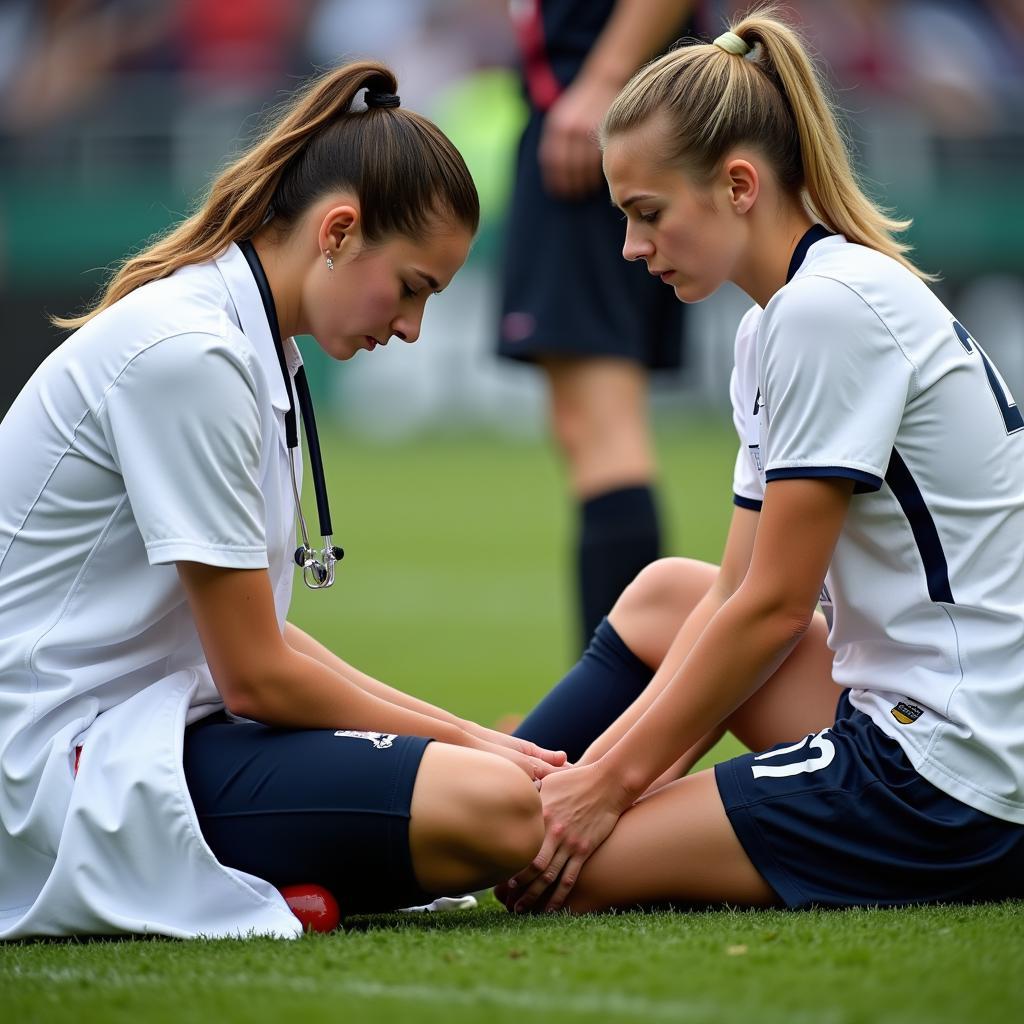Female Footballer Requires Emergency Medical Attention
November 20, 2024A female footballer needing emergency medical attention highlights the importance of player safety in the sport. This article delves into the various reasons why a female player might require urgent medical care, preventative measures, and the overall importance of prioritizing player well-being.
Why Might a Female Footballer Need Emergency Medical Attention?
Female footballers, like their male counterparts, face a range of potential injuries and medical emergencies on the pitch. These can range from traumatic injuries like concussions and fractures to cardiac events and heatstroke. Understanding these potential issues is crucial for implementing effective preventative measures.
- Traumatic Injuries: Collisions, tackles, and falls can lead to serious injuries like concussions, fractures, sprains, and dislocations. These often require immediate medical attention to stabilize the player and prevent further damage.
- Cardiac Events: Although rare, cardiac events can occur in athletes, including female footballers. Sudden cardiac arrest can be life-threatening and requires immediate CPR and defibrillation.
- Heatstroke/Exhaustion: Playing in hot and humid conditions can lead to heatstroke or heat exhaustion. These conditions can be serious and require rapid cooling and rehydration.
- Asthma Attacks/Respiratory Issues: Exercise-induced asthma or other respiratory problems can be exacerbated during intense physical activity, requiring immediate medical intervention.
- Allergic Reactions: Players may experience allergic reactions to insect stings, medications, or other environmental factors, requiring prompt treatment with antihistamines or epinephrine.
Preventing Medical Emergencies in Women’s Football
Preventing medical emergencies is paramount. A proactive approach to player safety can significantly reduce the risk of serious incidents.
- Pre-Participation Screening: Comprehensive medical evaluations before the season can identify potential health risks and allow for appropriate management.
- Proper Warm-up and Cool-down: Adequate warm-up prepares the body for activity, while cool-down helps prevent muscle soreness and injury.
- Hydration and Nutrition: Maintaining proper hydration and nutrition is essential for optimal performance and injury prevention.
- Safe Playing Environment: Ensuring a safe playing surface and enforcing rules against dangerous play can minimize the risk of traumatic injuries.
- Emergency Action Plan: Having a clear emergency action plan in place, including access to trained medical personnel and equipment, is vital for responding effectively to medical emergencies.
- Education and Awareness: Educating players, coaches, and referees about potential medical emergencies and appropriate responses is essential for promoting player safety.
 Female Footballer Receiving Medical Attention on Sidelines
Female Footballer Receiving Medical Attention on Sidelines
Prioritizing Player Well-being: A Shared Responsibility
Player well-being should be the top priority in women’s football. It requires a collective effort from players, coaches, medical staff, and governing bodies to create a culture of safety and support.
What can coaches do to prevent injuries?
Coaches play a crucial role in fostering a safe environment by emphasizing proper training techniques, promoting fair play, and prioritizing player health over winning at all costs.
How can players contribute to their own safety?
Players are responsible for adhering to safety guidelines, reporting injuries promptly, and taking care of their physical and mental well-being.
Conclusion
The need for a female footballer to require emergency medical attention underscores the importance of prioritizing player safety in women’s football. By implementing preventive measures, educating stakeholders, and fostering a culture of well-being, we can create a safer and more supportive environment for these athletes. Player safety should always be the primary concern.
FAQ
- What are the most common injuries in women’s football?
- How can heatstroke be prevented in female athletes?
- What is the role of a team physician in player safety?
- What should a player do if they suspect a concussion?
- How can parents contribute to the safety of their daughters in football?
- What are the long-term effects of untreated sports injuries?
- Where can I find more information about player safety in women’s football?
Need support? Contact us 24/7: Phone: 0396443476, Email: [email protected], or visit us at 23 Tháng 3, Đắk Nia, Gia Nghĩa, Đắk Nông, Vietnam.